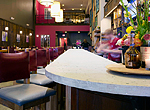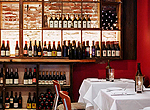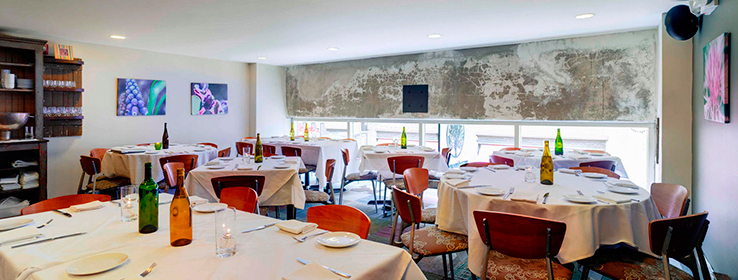Kim Palmer
A green-spirited gastropub puts a local spin on the French bistro tradition.
Cleveland’s Greenhouse Tavern has racked up a lot of accolades in its relatively young life: Bon Appetit proclaimed it one of the “Top 10 Best New Restaurants in America,” while chef/owner Jonathon Sawyer took “Best New Chef” honors from Food & Wine.
Sawyer’s justifiably proud of his food, which focuses on the finest locally sourced ingredients the Cuyahoga Valley has to offer. But he’s equally proud of his tavern’s home, which broke new ground in sustainability, becoming the first nationally certified green restaurant in the state of Ohio.
Asked about his favorite compliment, Sawyer says: “When we first opened, a friend said, ‘This feels like you’ve been here forever.’ That’s what we wanted: comfortable.”
The challenge of making a brand-new restaurant feel like it had been there forever was embraced by designer and sustainability director Jonathan Sin-Jin Satayathum of ::designspace. An area native, he’d returned several years earlier and was eager to take part in a project that would contribute to the city’s revival. “Cleveland is very special to me,” he says. “It’s gone through the gauntlet and is re-emerging as a high-quality place to live.”
Satayathum had worked with Sawyer and co-owner Jonathan Seeholzer at Lolita bistro in Cleveland, the acclaimed restaurant of “Iron Chef” Michael Symon. Their concept for a unique gastropub started with scribblings on a bar napkin and soon came to life.

Locavore mecca
Sawyer had operated other restaurants, including the Brooklyn Burger Bar in New York, but he and his wife and business partner, Amelia Zatik-Sawyer, were ready to put down roots and contribute to Cleveland’s burgeoning locavore culinary scene.
“We know Ohio has some of the best produce in all of America,” Sawyer says.
Before opening the tavern, Sawyer went to France for an entire month. He wanted to soak up the Parisian bistro experience and interpret it for an Ohio dining crowd, using local ingredients from the area’s farmers, brewers and butchers.
But harvesting local food sources was just the beginning. Sawyer and company also planned to harvest local materials and tap the local business community to create the building itself. “It was part of one big vision,” Sawyer says.
To that end, the team committed to housing their new restaurant in an existing building. “The greenest space is one already built,” Sawyer says. They settled on the historic Cort’s building in downtown Cleveland’s East 4th Street entertainment district. The long narrow building, built in the late 1800s, was wedged between a bar and the House of Blues. It had previously been a shoe store and a wig shop, but it had long been vacant and in decline when the Greenhouse Tavern team rescued it.
“It was an empty shell,” Satayathum recalls. “There was no HVAC system, almost no plumbing or electricity.” Squatters had staked their claim, and there was a foot of garbage in the basement. “It was just falling apart,” he says.
Nonetheless, they liked the building’s downtown location and could see its potential. “The façade had a lot of Art Deco elements - sandstone sculpting and fluted aluminum accents,” Satayathum says.
Satayathum, who became a LEED Accredited Professional during the course of the project, pursued certification from the Green Restaurant Association, which has green criteria established specifically for the food-service industry.
Sourcing and salvaging
Bringing new life to recycled materials was a big part of that green vision. The team, led by Satayathum, devoted a full year to sourcing: tracking down installers, suppliers, fabricators, fixtures and materials through online research, letter-writing campaigns and personal visits.
Satayathum worked with Old School Architectural Salvage to find local materials and put them to creative new use. The first-floor dining area, for example, is finished with cedar barn wood sourced in Jefferson, Ohio, from a barn that stood during the Civil War era. Oak flooring and framing from Ohio farmhouses became bar stools, chairs and shelves. Many of the English oak tables, counters and cabinets were salvaged from the old science teaching labs at a nearby university. Other furnishings and fixtures from the neighborhood included vintage church benches, bar tables, aluminum bistro chairs, chandeliers and a vintage 1970s jukebox that spins 45s.
Dramatic light fixtures are a must-have for a stylish dining spot, Satayathum notes, but instead of importing costly ones from faraway factories, the team came up with a creative, locally sourced alternative: They toured a local bike co-op and found rims just the right size to create custom LED fixtures with eco-friendly fabric stretched over the metal.

Crafting the restaurant’s bar tops was equally inventive. The team admired a recycled glass and concrete material manufactured in New York, but it was prohibitively expensive, Satayathum says. “We thought, ‘We can do this.’ So we collected bottles and smashed ‘em up in 55-gallon drums.” They also harvested curtain-wall glass, originally fabricated for skyscraper façades, but with cosmetic imperfections. Their contractor embraced the challenge and mixed the glass shards into cement to create sustainable, durable and beautiful surfaces. “We saved 1,000 pounds of glass from the landfill,” Satayathum says.

Old wine and beer bottles also play a starring role in the Tavern’s unique metal staircase. They’re lit from behind and used as a decorative element behind the risers, an effect inspired by the quartz lenses from a stair in a nearby Victorian arcade. “It ended up being the world’s biggest Lite Brite,” Satayathum says, in reference to the illuminated children’s toy. “We didn’t want to be green snobs; we wanted it to be fun.”
The search for local, green-minded suppliers inevitably led to hometown-based Sherwin-Williams, which provided Duration Home® and Harmony® paint products, as well as Waterborne Acrylic Dryfall and wallpaper adhesives.
“Indoor air quality and safety are fundamental to sustainability,” says Satayathum. “I spec all Sherwin-Williams now; I just like the product.”
Sherwin-Williams colors used in the Greenhouse Tavern














